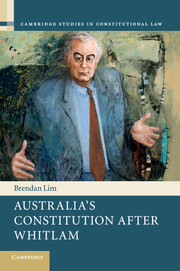1 - Introduction
Published online by Cambridge University Press: 06 April 2017
Summary
New Questions
This book is about the Australian constitutional crisis of 1975. It is, more precisely, about the continuing legacy of the crisis in contemporary constitutional law. Uncovering that continuing legacy is not easy work. It has been obscured by the standard narratives, told and re-told over the last 40 years, which portray the crisis as an exceptional moment, an aberration from the constitutional tradition rather than a manifestation of that tradition's deepest commitments.
The facts of the crisis were, to be sure, quite extraordinary. On coming to power in 1972, Prime Minister Gough Whitlam's Labor government faced persistent opposition from a hostile Senate. The Senate blocked major legislative reforms and ultimately determined to force early elections by withholding the government's financial supply. Whitlam acceded to the Senate's demands once, calling a double dissolution election in 1974 following which he was returned to government. When Whitlam refused to advise a second early election in 1975, the Governor-General, Sir John Kerr, decisively intervened to break the deadlock by dismissing the government from office.
Underneath these extraordinary facts was a more enduring question of principle. It was the very question that animated the conflict between Whitlam and the Senate in the first place: what are the legitimate processes of informal constitutional change in Australia? Whitlam, from well before 1975, had been engaged in an ambitious programme of constitutional transformation outside existing procedures for formal constitutional amendment. By ordinary lawmaking, rather than by referendum, Whitlam sought to weaken prevailing understandings of a federal balance and to expand the power and responsibilities of the central government in order to deliver social welfare programmes on an unprecedented national scale. He relied on novel interpretations of federal power, coercive conditions on state finances and the appointment of sympathetic judges.
Australia's constitution is a hybrid one, combining and adapting both British and American institutions and forms. Emphasising the British inheritance, Whitlam staked the legitimacy of his creative efforts on the fact that he commanded the confidence of the House of Representatives, which he portrayed as the institution enjoying constitutional priority and superior democratic legitimacy. The Senate, ultimately backed by the Governor-General, emphasised American aspects of the hybrid arrangements. In resisting Whitlam's innovations, it rejected the notion that the House of Representatives was anything more than a co-equal institution.
- Type
- Chapter
- Information
- Australia's Constitution after Whitlam , pp. 1 - 13Publisher: Cambridge University PressPrint publication year: 2017

